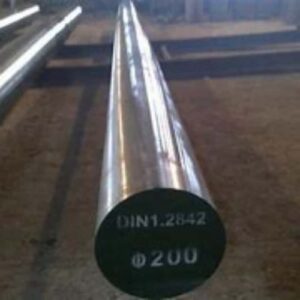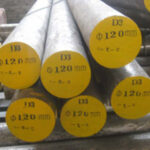Introduction
Automotive manufacturing involves thousands of stamping and forming operations to shape sheet metal components for vehicle bodies, frames, drivetrains and interiors. The tooling steels used to make dies and molds for automotive high volume stamping and forming impact both productivity and final part quality. This article explores the demanding durability and efficiency requirements of automotive stamping/forming tool steels as well as leading grades and processing methods enabling improved manufacturing throughput.
Challenges of Automotive Stamping and Forming
 Automotive production volumes impose particular demands on stamping and forming tooling:
Automotive production volumes impose particular demands on stamping and forming tooling:
- Withstand millions of high frequency loading cycles without failure
- Resist wear, galling and damage from abrasive metal removal
- Endure exposure to lubricants and cleaning chemicals
- Maintain dimensional accuracy for consistent parts within tight tolerances
- Enable quick die changes to minimize downtime
- Allow short cycle times for maximum output
- Operate at elevated temperatures from high speed stamping
- Ensure final part quality and correct split lines from progressive dies
- Provide quick knock-out to avoid part sticking
Tool steel selection, processing, coatings and design must be optimized to fulfill these challenging requirements.
Key Properties for Automotive Tool Steels
Automotive production demands a balance of properties:
Wear Resistance
Constant cyclic shear and compressive contact with sheet metal causes severe abrasive wear. Wear resistant tool steels maintain die life.
Galling Resistance
Adhesion and microscopic welding between dies and formed parts results in galling and scoring. Tool steel composition and coatings minimize this.
Toughness
Shock loads from thousands of stamping impacts per minute require good fracture toughness to avoid cracking failures.
Fatigue Strength
Resistance to progressive crack growth from cyclic stresses ensures longevity through millions of operating cycles.
Hardness
Sufficient hardness between ~HRC 48-54 enables tooling to withstand high contact pressures without excessive deformation that would impair dimensional accuracy.
Corrosion Resistance
Punches, dies and trim tooling must resist corrosion from prolonged exposure to water-based lubricants, cleaners and metalworking fluids.
Thermal Stability
Elevated die temperatures from high speed stamping require tool steels that retain hardness and strength with minimal distortion at service temperatures exceeding 400°F.
Dimensional Stability
Consistent production output depends on tool steel components maintaining shape and critical dimensions without distortions from residual stresses or ongoing use.
The right balance of these properties allows automotive tool steels to withstand extreme stamping environments.
Leading Tool Steel Grades
Widely used tool steel options for automotive stamping/forming include:
H13 Hot Work Steel
The most prevalent grade due to an optimal mix of wear and heat resistance, toughness, and cost effectiveness. 5% chrome and 1.5% molyenhances hardenability and tempering resistance.
P20 Mold Steel
Excellent machinability before heat treating facilitates manufacturing dies with the required dimensional accuracy. Superior stability in service and easier post-heat treat machining than H13.
D2 Cold Work Tool Steel
High chromium and 1% vanadium content impart exceptional wear resistance leading to maximum die life. More difficult to machine than H13.
420 Stainless Steel
Corrosion resistant with good hardness capability when high-carbon 420 is used. Best option when lubricant staining of parts is undesirable. More expensive than other tool steels.
High Speed Steels
The hot hardness of high speed steels like M2 retain sharp cutting edges on trim and piercing dies. Not as dimensionally stable as hot work steels.
Maraging Steels
Exceptional strength and dimensional precision for stamping thin, ultra high-strength steels requiring extreme accuracy. Cost is prohibitive for most applications.
Proper grade selection maximizes the durability, productivity, and capabilities of automotive stamping tooling.
Key Design Elements
Along with material selection, tool steel die and mold component design also impacts performance:
Draft Angles
Tapered walls, shoulders, and lifters facilitate easy part ejection and prevent sticking that slows cycle times. Draft requirements increase for higher strength or coated sheet metals.
Split Lines
Proper placement of split lines enables precision alignment while allowing easier die maintenance and machining compared to large monoblock dies.
Venting/Vacuum Channels
Venting channels prevent air entrapment between sheet and dies during high speed stamping. Vacuum channels improve thin sheet metal forming capability.
Cooling Design
Conformal cooling channels maximize heat removal and thermal stability. Location, size, layout, and flow balancing prevent localized heat concentrations.
Surface Texturing
Deterministic micro surface patterns reduce friction while enhancing lubricant retention between tooling and sheet metal. This prevents galling and aids durability.
Coatings
Thin PVD coatings like TiN, TiCN, and CrN shield stamping tool surfaces against wear, friction, corrosion and galling while retaining dimensional precision.
Advanced design and engineering of automotive tooling components is essential to fully optimize their performance and capabilities in service.
Machining and Grinding Methods
Specialized techniques produce the required precision ground surfaces and complex 3D geometries of automotive stamping/forming tool steels:
CNC Milling
Precise 3-axis and 5-axis CNC milling centers enable intricate die shapes needed for curved panels and structural components with minimal secondary polishing or benching required.
EDM
Complex conformal cooling designs and other challenging geometries are machined into tool steel components using wire or sinker electrical discharge machining methods.
CNC Grinding
Advanced CNC grinding technology imparts necessary surface finishes down to less than 10 Ra microinches. Spark-out and in-process gaging improve flatness and parallelism.
Laser Machining
Lasers cut small precision features or selectively ablate localized regions with minimal distortion to adjacent areas.
Polishing
Multi-stage fine abrasive polishing removes subsurface damage from machining or EDM to achieve super-finished mold surfaces.
Dedicated machining and grinding processes allow tool steels to meet the challenging dimensional requirements for automotive stamping.
Heat Treating Considerations
Proper heat treatment of tool steels maximizes service performance:
Normalizing
Normalizing relieves internal stresses from machining or grinding prior to hardening. This minimizes subsequent distortion during heat treating.
Austenitizing
Thorough heating for complete austenite transformation enables proper hardening upon quenching and improves uniformity.
Rapid Hardening
Fast quenchants like pressurized gas or warm polymer solutions produce maximum hardness while controlling distortion.
Tempering
Low temperature (400-600°F) tempering imparts desired balance of tool steel hardness and toughness for stamping duty. Multiple tempers ensure stability.
Precipitation Hardening
Secondary hardening heat treatments for PH grades further increase hardness, strength, and dimensional precision. This is critical for high production stamping tools.
Stress Relieving
Final stress relief removes any residual stresses from prior machining or grinding to maximize stability in service.
Heat treating refinements boost the capabilities and durability of tool steels for automotive production.
Surface Engineering and Coatings
 Surface treatments transform the surface properties and performance of automotive tool steels:
Surface treatments transform the surface properties and performance of automotive tool steels:
Nitriding
Gas or plasma diffusion processes harden and densify surface layers to resist wear, galling and fatigue crack initiation without distorting dimensions.
PVD Coatings
Thin, dense PVD coatings like CrN and nc-TiN optimize hardness, lubricity, and corrosion resistance at tool-workpiece interfaces during stamping and forming.
CVD Coatings
Thicker CVD coatings provide extreme abrasion resistance for trim steels and punch faces exposed to scoring from sheared edges.
Laser Surface Texturing
Deterministic microscale surface patterns reduce friction against sheet metals, enhance lubricant retention, and improve durability.
Electropolishing
Electrolytic polishing removes microscopic surface roughness and asperities to enable release of stamped parts without galling or adhesion. High luster surfaces also result.
Plating
Thin electroplated metal coatings like chromium or nickel improve corrosion and wear protection for enhanced tool steel stamping component longevity.
These surface engineering processes enable tool steel dies and molds to reach their full potential productivity in high volume automotive manufacturing environments.
Conclusion
The capabilities of automotive stamping and forming tool steels must be fully leveraged to withstand extreme contact pressures and temperatures across millions of operational cycles in high production environments. The right combination of optimized tool steel grades, precision machining and grinding methods, heat treatment, and surface engineering allows component dies, molds and tooling to repeatedly deliver auto parts within precise dimensional tolerances at maximum manufacturing rates. With ongoing advances, tool steels will continue proving essential for economically forming the next generation of automotive designs.
Frequently Asked Questions
What hardness range is typically needed for automotive stamping tool steels?
A hardness between ~HRC 48-54 balances wear resistance with enough fracture toughness to endure cyclic loading. Specific hardness targets depend on part geometries and sheet metal strengths involved.
What causes galling on automotive stamping tool steels?
Adhesion between dies and formed parts leads to microscopic welding and material transfer. Galling arises from poor lubrication, adhesion tendencies of formed metals, and insufficient tool steel hardness or compatible coatings.
How does die split line design impact stamping tool steel performance?
Proper split line placement balances accessibility for machining and maintenance against precision alignment requirements. Poor split line design causes premature failure or dimensional quality issues.
Why is vacuum or venting needed in some automotive stamping dies?
Venting prevents air entrapment between sheet and dies that would cause defects during high speed stamping. Vacuum enhances forming capability for hard-to-draw sheet metals.
What temperatures can automotive tool steels withstand?
Most grades perform well up to 400-500°F. Special hot work tool steels handle temperatures approaching 1000°F for hot forming of high strength steel or aluminum panels and structures.
How many stamping cycles do automotive tool steels last?
With optimal grades and processing, tool life spans 1-2 million strokes. Wear resistant grades like D2 can reach 5 million cycles. Effective cooling and coatings also prolong service life.
How thick should PVD coatings be on automotive stamping dies?
Thin yet dense PVD coatings around 3-5 microns thick provide maximal wear and galling protection without altering tool steel dimensions or tolerances. Thicker coatings risk flaking.
What causes tool steels to distort during heat treating?
Uneven heating/cooling and residual stresses from prior machining lead to distortion. Normalizing, preheating, optimized hardening and tempering cycles, and stress relieving minimizes this risk.
How does electropolishing help automotive stamping tool steels?
Electropolishing removes microscopic peaks that can cause galling. The resulting ultra-smooth surfaces allow easy release of stamped parts without adhesion or scoring defects.
How could 3D printing help produce automotive tooling components?
Additive manufacturing enables complex consolidated assemblies and bionic geometries to reduce weight while optimizing cooling, venting, vacuum and durability performance.

